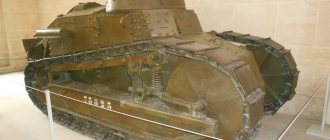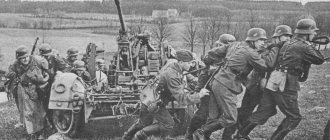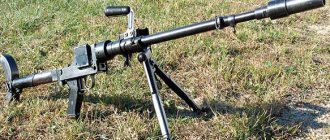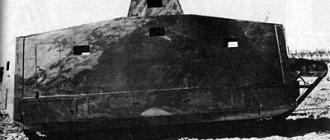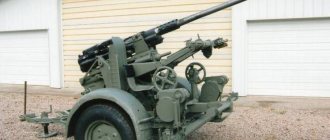"Flying tank" Il-2
The experience of combat operations during the Spanish Civil War showed the significant role of air assault operations. The USSR was tasked with creating an attack aircraft with powerful offensive and defensive weapons. And such an aircraft was created at the S.V. Ilyushin Design Bureau. The main feature of the Il-2 was the armored hull, which protected the pilot and navigator. The development and production of the aircraft immediately encountered many difficulties, and to speed up the process, it was decided to initially establish the production of a single-seat Il-2, which did not remove the task of creating a two-seat attack aircraft. The aircraft's basic armament consisted of two 20 mm. ShVAK guns and two 7.62 mm. ShKAS aviation machine guns. The aircraft could carry RS-82 or RS-132 missiles and aerial bombs. The production of IL-2 was initially launched in Voronezh at plant No. 18.
Sergei Vladimirovich Ilyushin [1894 - 1977]. (xexe.mirtesen.ru)
One of the first mass uses of the Il-2 was noted on June 27, 1941, when the Il-2s of the 4th attack air regiment attacked a German column in the Bobruisk area. It was the only Soviet air regiment at that time fully equipped with new attack aircraft. In the following days, the regiment prevented the enemy from crossing the Berezina, destroying 9 crossings. However, the losses turned out to be very significant. Of the 63 aircraft, by July 10, 1941, no more than ten aircraft remained in service and the regiment was withdrawn for reorganization. Subsequently, the number of “silts” in the active army gradually increased. However, the situation with the production of Il-2 in the conditions of evacuation and the transfer of industry to a military footing remained difficult, and the number of attack aircraft produced in the most difficult conditions clearly did not meet the needs of the army. Stalin’s telegram dated December 23, 1941 addressed to the management of aircraft factories No. 1 and No. 18 noted: “You have failed our country and the Red Army. You have not yet deigned to produce IL-2. Our Red Army now needs Il-2 aircraft like air, like bread. Shenkman gives one Il-2 a day, and Tretyakov gives one or two MiG-3s. This is a mockery of the country, the Red Army. We don't need MiGs, but IL-2s. If the 18th plant is thinking of shaking itself off from the country by producing one IL-2 per day, then it is cruelly mistaken and will suffer punishment for it. I ask you not to make the government lose patience and demand that more Ilov be released. I’m warning you for the last time.”
Single seat IL-2. Spring 1942 (fotowarmotors.ru)
The combat use of the Il-2 revealed vulnerability from the rear hemisphere, from where German fighters often attacked the Soviet attack aircraft. Therefore, in the fall of 1942, the army began to receive a two-seat version of the attack aircraft. Shooter armed with 12.7 mm. The UB machine gun covered the rear hemisphere, which somewhat reduced the risk of an unpunished attack by enemy fighters. An attempt was made to arm the Il-2 with a more powerful 37 mm. NS cannon, however, practice has shown significant recoil of this weapon, which made it difficult to use by an attack aircraft. In addition, the Il-2, armed with two 23-mm VYa cannons, became widespread. Starting with the Battle of Kursk, Soviet attack aircraft began to use such a military novelty as PTABs. Anti-tank cumulative bombs, when meeting a target, produced a directed cumulative jet capable of penetrating 60 mm of armor due to colossal pressure and temperature. Often, when hit by such a bomb, the ammunition detonated or the fuel ignited; the tank burned out completely and could no longer be restored. Each Il-2 carried 280 cumulative bombs, ensuring target destruction over an area of 75 X 15 meters, which made it possible to effectively use cumulative bombs against accumulations of equipment.
The IL-2 has also found combat use as part of the naval aviation. If initially fleet attack aircraft operated mainly against ground targets, supporting the actions of ground forces, then since 1942 Il-2s increasingly began to operate against ships and naval bases. Especially often, the Il-2s of the Black Sea Fleet were involved in operations on enemy communications in the Kerch Strait, where the Germans used small maneuverable ships and vessels, against which the use of bombers was difficult. However, sinking even a small ship using cannon and machine gun fire or attack aircraft rockets turned out to be very difficult. Only air bombs could cause fatal damage, and the Il-2 could only take two FAB-250s. On November 13, 1943, Soviet aviation launched a massive attack on the Kamysh-Burun naval base. Bombers and fighters damaged several ships and caused serious damage to the port infrastructure. Among those killed in this raid was the commander of the German Navy on the Black Sea, Vice Admiral Gustav Kieseritzky, whose staff car was shot up by Soviet attack aircraft. He became the first German admiral to die on the Eastern Front.
Anti-tank cumulative bombs. TsMVS, Moscow. (armedman.ru)
The losses of the Il-2 throughout the fighting were also significant. At the beginning of the war, the Il-2 often became a victim of German fighters, who quickly discovered the weak point of the Soviet attack aircraft and attacked the Il-2 from the rear hemisphere. The armored hull was capable in some cases of withstanding bullets, but was almost always penetrated by automatic cannon shells. Towards the end of the war, losses from fighter aircraft began to gradually decrease. This was due to a decrease in the activity of German fighters due to significant losses and a lack of experienced personnel. In turn, the stormtroopers operated in large groups, providing mutual protection. The fighter cover also became stronger. However, most of the Il-2 was lost as a result of anti-aircraft artillery fire. High saturation of enemy defense with machine guns, 20 mm and 37 mm. automatic cannons led to the fact that an Il-2 attack was often met with a shower of bullets and shells, and almost every massive strike was not without losses for Soviet aviation. Subsequently, with the increase in the number of attack aircraft, the Il-2 unit was tasked with suppressing enemy air defenses, for which at least half of the attacking aircraft were often allocated. And when attacked by an enemy who did not have anti-aircraft or air cover, the Il-2s inflicted colossal damage on the German troops. For example, during Operation Bagration in the Mogilev and Osipovichi directions, German troops were forced to retreat into wooded and swampy areas along several roads loaded with troops and equipment, which created favorable conditions for the use of attack aircraft. One of the German prisoners testified: “All the roads of our retreat are strewn with thousands of broken cars and carts, corpses of horses and soldiers. The moral impact of Russian aviation was enormous. When Soviet planes appeared, the soldiers abandoned their cars and carts on the roads and ran to hide in the forest.”
In total, during the Great Patriotic War, 34943 IL-2 and 1211 IL-2U (trainer) were produced. The combat losses of the Il-2 amounted to 10,759 units - this is about 29% of all Soviet aircraft lost by the Red Army during the war. The Navy lost another 807 attack aircraft. The losses of the pilots who fought on the Il-2 amounted to 7,837 people.
Steel armor and wood wings
Aircraft designer Sergei Ilyushin developed his attack aircraft as a counterweight to the successful German Junkers Ju 87 Stuka model. Hitler's vehicles were distinguished by their ability to very accurately drop shells on the positions of ground forces and tanks, which caused significant damage to the enemy. Ilyushin was faced with the task of creating the easiest to assemble and cheapest aircraft, which could at the same time be a worthy competitor to German attack aircraft.
The aircraft designer intended to install armor on the Il-2, but he understood: if you simply screw armored plates onto the plane, it will fly like a brick. And then he proposed the following: steel armor becomes the strength element of the attack aircraft’s design, replacing the frame and skin of the entire nose and middle part of the fuselage, while its rear part and wings, as before, are made of wood.
Several prototypes were made, and eventually the single-seat Il-2 went into mass production, weighing almost 4.5 tons, while the Junkers weighed 3.2 tons. The maximum bomb load for both vehicles was approximately the same and amounted to about 500 kilograms. But the IL-2 was a little faster, with a speed of 400 kilometers per hour. It was better armed: two 20-mm cannons and two machine guns in the wings. Armor ranging from five to 12 millimeters thick protected the cabin, fuel tanks, AM38 engine and radiators. Even the cockpit canopy was made of armored glass six centimeters thick! The attack aircraft's chassis was extremely durable, allowing it to be landed on uneven front-line airfields.
Victories and losses
However, the situation in the skies on the Eastern Front was so desperate that the Il-2 often performed fighter missions. The attack aircraft could not keep up with the German fighter planes, but it proved a lethal means of destroying the slower German bombers, reconnaissance aircraft and transports.
Attack aircraft strikes played a vital role in the winter of 1942-43, depriving the German 6th Army locked in Stalingrad of supplies. At the airfield in Salsk, Il-2s destroyed 72 German aircraft, and shot down many transport workers in the air. But the greatest moment of glory for the attack aircraft was the epic Battle of Kursk, which went down in history as the greatest tank battle. No less majestic was the battle in the air, in which 500 aircraft took part. The Germans lost several dozen, and the Soviets - about a hundred vehicles. But the initial failure did not stop the Soviet command, which brought additional attack aircraft into the battle. In the battle of Kursk, Il-2 pilots began to perform a “carousel of death” over the battlefield, covering each other’s tails from enemy fighters. Periodically, attack aircraft one by one left the general formation to strike ground targets, and then returned to the circle. During the same period, Soviet attack pilots began to use some military tricks. They noticed that after the bombing the plane became much lighter, and powerful engines made it possible to reach high speeds. This made Il a fighter. The lightweight IL-2 became capable of giving a tough rebuff to any German Junkers or Messerschmitt.
By 1943, the Air Force adopted the Il-2M3 variant, which eliminated many of the shortcomings of its predecessor aircraft. The rear gunner finally received armor protection 13 millimeters thick, and the ends of the wing consoles were moved back 15 degrees to change the center of gravity. This significantly improved the control of the attack aircraft. Until the end of the war, thousands of attack aircraft provided air support to the Red Army. They bombed the last defenders of Berlin during the difficult four-day battle on the Seelow Heights. Soviet archives indicate that a total of 11,000 Il-2s were lost during World War II, although some sources claim losses were twice that number.
BY THE WAY
Il-2 became the most produced combat aircraft in the history of aviation. In total, more than 36 thousand cars were produced. In the Wehrmacht it was called the “Black Death”, “meat grinder” and “iron Gustav”, and also “concrete plane” - for its high combat survivability. It was an effective attack aircraft that helped, albeit at great cost, to win that terrible war.
